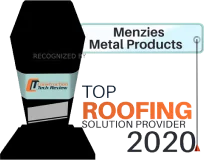As our main article mentions, scupper drains funnel water off flat roofs to prevent immediate or long-term damage due to ponding water.
This article will further discuss box scuppers’ uses, installation, and maintenance.
What Are Box Scuppers?
Box scuppers are closed or open metal boxes that drain water through the curbs or parapets on the roof’s edge. They can complement a flat roof’s internal drainage system to ensure efficiency or, in some cases, be its primary drainage system.
Parapets are low walls around a flat roof. Their main purpose is to prevent people from falling off. They also help contain gravel within the roof’s area.

Photo source: www.roofonline.com
Key Considerations for Choosing Box Scuppers
According to the roof edge’s design (parapet or curb), there are two types of box scuppers to choose from:
- Open-top box scupper.
- Closed box scupper.
Let’s look at the suitable applications for each type.
Suitable Applications for Open-Top Box Scuppers
The open-top box scupper, or “channel” scupper, is a rectangular box with its top open. It helps remove water laterally off a roof without a parapet wall.
A real-life scenario for installing open-top box scuppers would be a flat roof with curbs where you must drain water to an adjacent roof or when you need to add drainage to a flat roof and cannot add more vertical drains.
Channel box scuppers are cheaper, more time-consuming to install, and not nearly as good as closed-box scuppers.


Suitable Applications for Closed Box Scuppers
The closed box scupper or “through-wall” scupper drains water through parapets. It has a flange around its inlet to adhere to the roof membrane.
Some closed-box scuppers, like Menzies’s clamp-tite products, include a mechanical clamping plate that offers a more secure attachment to the membrane and, thus, better sealing.
Photo source: www.copper.org


Material and Durability
Due to their durability, copper and aluminum are the most common materials for box scuppers. They are non-ferrous metals, meaning they don’t contain iron, which allows them to resist rust.
Instead, copper and aluminum produce an oxide layer when exposed to air, moisture, rain, or seawater. The copper/aluminum oxide layer protects the underlying metal against further corrosion.
That said, there are very few functional differences between aluminum and copper. In most cases, it will boil down to your personal preference.
So, if the problem is corrosion, why not use PVC box scuppers? PVC has some drawbacks compared to metal. Some of them are:
- It may become brittle in freezing temperatures and soften in very high ones, leading to cracks or failures.
- PVC is sensitive to ultraviolet (UV) light. Prolonged exposure to sunlight causes it to degrade and become brittle.
Installation and Maintenance of Box Scuppers
Here are some best practices and mistakes to avoid when installing and maintaining your box scuppers.
Best Practice: Don’t Use Dissimilar Metals
Dissimilar metals are metals with significantly different properties that react when they come into contact, causing galvanic corrosion.
Ideally, to avoid a galvanic reaction, roofing nails should match the material of their corresponding box scuppers: copper nails for copper scuppers and aluminum nails for aluminum scuppers.
Most people use hot-dip or electro-galvanized aluminum or steel roofing nails because they cost less than copper and are highly resistant to corrosion and rust. However, the zinc coating wears off, especially in harsh weather, leading to rust.
A better option is stainless steel roofing nails. Although they cost more than galvanized roofing nails, stainless steel nails are far more corrosion-resistant, especially in marine environments.
At Menzies, our box scuppers include stainless steel fasteners, guaranteeing maximum durability to our products.
Mistake: Installing the Box Scupper Underneath the Roof Membrane
Do not install box scuppers underneath the roof EPDM membrane.
Water will eventually get underneath the membrane at the scupper’s inlet, causing leaks and moisture damage.
To correctly install a box scupper and prevent leaking, do the following:
- Cut a hole through the EPDM membrane and parapet for the scupper—there’s no need to cut an oversized hole to pass the scupper through the wall.
- Apply butyl sealant to the scupper flange or around the parapet hole.
- Pass the scupper through the hole and press it firmly against the parapet.
- Fix the scupper using nails.
- Cover the scupper flange with flashing tape and seam seal the flashing edges.
- Install the clamping plate and the strainer if they are included.
Regular Maintenance Tips
Although box scuppers are low maintenance, they can and do get plugged, as this member of the Eng-Tip Engineering Forum, who goes by the username CVG, claims. Regularly check scuppers to remove debris.
Besides keeping the scuppers free of debris (especially after a downpour), check the butyl seals.
Caulking seals eventually wear off, allowing water to seep through cracks and gaps.

Photo source: www.andesroof.com
Conclusion
Scupper drains work along flat roofs’ internal drainage to remove water quickly and efficiently. They are a budget-friendly solution to prevent your roof from collapsing or deteriorating due to water ponds.
At Menzies, we maintain an unyielding commitment to ensuring the highest levels of quality in the design, manufacturing, and testing of our products. Visit our website and check out our vast catalog of flat roof drain solutions.



